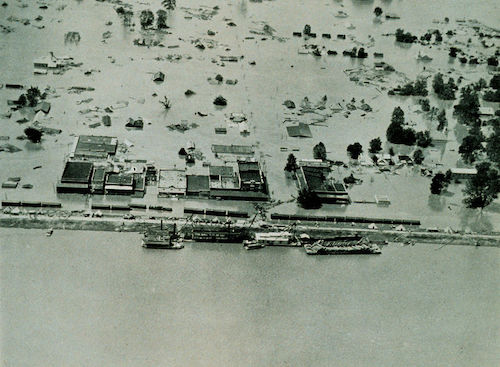
We’re back on flood watch. And we’d almost forgotten there was such a thing.
After a summer of nation-wide droughts and dry-spells, the once-mighty Mississippi had shrunk from its swollen spring heights to a seeming trickle this fall. In my hometown of Vidalia, Louisiana, the river gauge dipped into the single digits.
Egrets and herons hunted formerly submerged sandbars that were now exposed ridges of silt and debris, hundreds of feet out into the channel. Barge and boat traffic came to a crawl as the navigable depths narrowed.
Locals joked about swimming the thing – though none were actually foolish enough to try. The unstoppable, south-bound churn of a 2,000-mile stream appeared at times to slow to a near standstill.
Now in November, the river is back on the rise. It’s raining here and half-a-continent away, as the weather makes its turn towards the wet and cold of winter.
There are still dozens of feet to go before “flood stage.” And even when the river likely laps against the levees and dams in April or May, the defenses will probably hold as they (almost) always have.
An aerial photo of the Mississippi River flooding in 1927. (Credit: Steve Nicklas, NOS, NGS / Wikimedia Commons / Public Domain / https://tinyurl.com/p5sk7w5m)
No one is making plans for an ark, yet. But just in case, we’ll keep an eye out. We’ve heard the stories of 1927 and 1973. Those endless miles of earthworks aren’t for nothing.
With a changing climate, the river’s record lows might just be followed by previously unthinkable highs. Towering groves of cottonwoods and sycamores and vast stretches of delta croplands are inescapable reminders of thousands of years’ worth of seasonal deluges that made this region home to some of the most fertile soil on the planet.
Oxbow lakes miles from the modern path of the Mississippi trace the story of an ever-moving power that might be delayed for a century or two, but never stopped.
On some subconscious level, you’re always on flood watch when you live in a floodplain. Advent is the church’s return to flood watch.
“As it was in the days of Noah,” Jesus says cryptically in Matthew 24-25’s Little Apocalypse. “Keep awake … Understand … Be ready, for the Son of Man is coming at an unexpected hour.”
Paul, too, has his eye on the rising tide in this Sunday’s reading from Romans. “The hour has already come for you to wake up from your slumber, because our salvation is nearer now than when we first believed. The night is nearly over; the day is almost here” (13:11-12).
Scholars have long noted the sense of apocalyptic imminence which pervades the New Testament, particularly in the synoptics and Paul’s earlier letters.
Debates abound about what Jesus might have meant when he said, “Truly I tell you, some who are standing here will not taste death before they see the Son of Man coming in his kingdom” (Matthew 16:28).
Still, Jesus is unequivocal about one thing: “But about that day and hour no one knows, neither the angels of heaven, nor the Son, but only the Father” (Matthew 24:36).
In other words, “when” and “how” is beside the point. Despite the obsessive hopes, fears and predictions in our own day about “the end” – whether ecological, cosmic or least of all political – it remains true that “you do not know on what day your Lord is coming.”
You can’t project just what the river will do and when she’ll do it. Instead, you prepare. You wait, and you watch.
What would it mean for God’s people today to return to holy expectation this Advent? What would it mean for us to get back on flood watch?
Can we allow the story of Christ’s first coming to erode our despair? In an age of wide-spread decline and division among churches, have we given way to the cynicism that says, “That’s just the way it is,” as if it always has been, and somehow must always be?
Will we let the shockingly good news of God’s coming into the world push back against our contentment and consternation with life as it is?
Herods and Caesars, long nights and bleak winters, and crosses and tombs seem unending and immovable. It’s hard to imagine a neighborhood – let alone a world – without rampant inequality and institutionalized injustice. It seems incredulous to envision, as Isaiah did, all the nations and all kinds of people united in peace by the light of the Lord.
And yet, Advent calls us to remember the boundaries this flood has already broken once before and might cross again even in our day.
This is the unmovable power that caused a Virgin to conceive a son and that commanded a frightened young man to welcome and name him as his own.
This is the unstoppable kingdom that comes for the poor, the mourner and the meek, wholly missed by the “powers that be” right up until the moment it topples them.
This is the flood of grace and truth that has watered the witness and work of two millennia of those who watch and wake.
We’ve heard the stories. We’ve seen the signs.
As often as we’re tempted to forget it, we’re still living on a floodplain. So, keep an eye out.
Editor’s note: This article is the first in a series for Advent 2022. Each week, an article will be published reflecting on one or more of the lectionary texts for the forthcoming Sunday.
Caldwell and his wife Brittany serve as co-pastors of Nobles Chapel Baptist Church in Sims, North Carolina. He is a lover of (almost) all things wild, including his soon to be four year old daughter. Chase is currently pursuing a Doctor of Ministry from Campbell University Divinity School, with a research focus on wilderness ministry for the local church. Find more of Chase’s work at awildernessway.blogspot.com.


